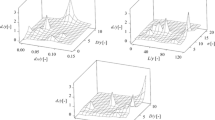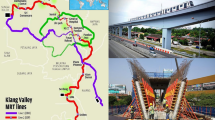Abstract
This study aims at establishing machine learning models based on the support vector regression (SVR) for estimating local scour around complex piers under steady clear-water condition. A data set consisting of scour depth measurement cases has been collected to construct the prediction models. The data set includes eight influencing factors that consider aspects of pier geometry, flow property, and river bed material. Moreover, to enhance the performance of the SVR model, filter and wrapper feature selection strategies are used. The research finding is that all feature selection approaches can help to improve the prediction accuracy compared with the SVR model that uses all available features. Notably, the feature selection method based on the variable neighborhood search (VNS) algorithm achieves the best performance (MAPE = 21.65%, R2 = 0.85). Accordingly, the prediction model produced by SVR and VNS can be useful for assisting decision makers in the task of structural health monitoring as well as the design phase of bridges.









Similar content being viewed by others
References
Mueller DS, Wagner CR (2005) Field observations and evaluations of streambed scour at bridges. Office of Engineering Research and Development Federal Highway Administration, McLean
Kallias AN, Imam B (2016) Probabilistic assessment of local scour in bridge piers under changing environmental conditions. Struct Infrastruct Eng 12:1228–1241. https://doi.org/10.1080/15732479.2015.1102295
Warren LP (2011) Scour at Bridges: stream stability and scour assessment at bridges in Massachusetts US Geological Survey
Deng L, Cai CS (2010) Bridge scour: prediction, modeling, monitoring, and countermeasures. Pract Period Struct Des Constr 15:125–134. https://doi.org/10.1061/(ASCE)SC.1943-5576.0000041
Landers MN (1992) Bridge Scour Sata Management. Published in Hydraulic Engineering: saving a threatened resource—in search of solutions. In: Proceedings of the Hydraulic Engineering sessions at Water Forum’92 Baltimore, Maryland, August 2–6, 1992 Published by American Society of Civil Engineers
Richardson EV, Davis SR (2001) Evaluating scour at bridges (HEC-18) Technical Rep No NHI 01-001. FHWA, Washington, DC
Hong J-H, Chiew Y-M, Lu J-Y, Lai J-S, Lin Y-B (2012) Houfeng bridge failure in Taiwan. J Hydraul Eng 138:186–198. https://doi.org/10.1061/(ASCE)HY.1943-7900.0000430
Raikar RV, Dey S (2005) Scour of gravel beds at bridge piers and abutments. Proc Inst Civ Eng Water Manag 158:157–162. https://doi.org/10.1680/wama.2005.158.4.157
Toth E (2015) Asymmetric error functions for reducing the underestimation of local scour around bridge piers: application to neural networks models. J Hydraul Eng 141:04015011. https://doi.org/10.1061/(ASCE)HY.1943-7900.0000981
Liao K-W, Hoang N-D, Gitomarsono J (2018) A probabilistic safety evaluation framework for multi-hazard assessment in a bridge using SO-MARS learning model. KSCE J Civ Eng 22:903–915. https://doi.org/10.1007/s12205-018-1291-0
Prendergast LJ, Hester D, Gavin K (2016) Determining the Presence of scour around bridge foundations using vehicle-induced vibrations. J Bridge Eng 21:04016065. https://doi.org/10.1061/(ASCE)BE.1943-5592.0000931
Wang C, Yu X, Liang F (2017) A review of bridge scour: mechanism, estimation, monitoring and countermeasures. Nat Hazards 87:1881–1906. https://doi.org/10.1007/s11069-017-2842-2
Zarafshan A, Iranmanesh A, Ansari F (2012) Vibration-based method and sensor for monitoring of bridge scour. J Bridge Eng 17:829–838. https://doi.org/10.1061/(ASCE)BE.1943-5592.0000362
Park C-W, Park HI, Cho Y-K (2017) Evaluation of the applicability of pier local scour formulae using laboratory and field data. Mar Georesour Geotechnol 35:1–7. https://doi.org/10.1080/1064119X.2014.954658
Melville B (2008) The physics of local scour at bridge piers. In: Proceedings of the Fourth International Conference on Scour and Erosion, Tokyo, Japan
Azimi H, Bonakdari H, Ebtehaj I, Ashraf Talesh SH, Michelson DG, Jamali A (2017) Evolutionary Pareto optimization of an ANFIS network for modeling scour at pile groups in clear water condition. Fuzzy Sets Syst 319:50–69. https://doi.org/10.1016/j.fss.2016.10.010
Arneson LA, Zevenbergen LW, Lagasse PF, Clopper PE (2012) Evaluating scour at bridges Publication No FHWA HIF 12-003. Federal Highway Administration, Washington, DC
Ataie-Ashtiani B, Baratian-Ghorghi Z, Beheshti AA (2010) Experimental investigation of clear-water local scour of compound piers. J Hydraul Eng 136:343–351. https://doi.org/10.1061/(ASCE)0733-9429(2010)136:6(343)
Melville BW, Coleman SE (2000) Bridge scour. Water Resources Publications, Littleton, Colo
Etemad-Shahidi A, Rohani MS (2014) Prediction of scour at abutments using piecewise regression. Proc Inst Civ Eng Water Manag 167:79–87. https://doi.org/10.1680/wama.11.00100
Muzzammil M (2010) ANFIS approach to the scour depth prediction at a bridge abutment. J Hydroinform 12:474–485. https://doi.org/10.2166/hydro.2010.004
Cheng M-Y, Cao M-T (2014) Hybrid intelligent inference model for enhancing prediction accuracy of scour depth around bridge piers. Struct Infrastruct. https://doi.org/10.1080/15732479.2014.939089
Choi S-U, Choi B, Lee S (2017) Prediction of local scour around bridge piers using the ANFIS method. Neural Comput Appl 28:335–344. https://doi.org/10.1007/s00521-015-2062-1
Firat M, Gungor M (2009) Generalized regression neural networks and feed forward neural networks for prediction of scour depth around bridge piers. Adv Eng Softw 40:731–737. https://doi.org/10.1016/j.advengsoft.2008.12.001
Hosseini R, Amini A (2015) Scour depth estimation methods around pile groups KSCE J. Civ Eng 19:2144–2156. https://doi.org/10.1007/s12205-015-0594-7
Zounemat-Kermani M, Beheshti A-A, Ataie-Ashtiani B, Sabbagh-Yazdi S-R (2009) Estimation of current-induced scour depth around pile groups using neural network and adaptive neuro-fuzzy inference system. Appl Soft Comput 9:746–755. https://doi.org/10.1016/j.asoc.2008.09.006
Najafzadeh M, Barani G-A, Hessami-Kermani M-R (2014) Group method of data handling to predict scour at downstream of a ski-jump bucket spillway. Earth Sci Inf 7:231–248. https://doi.org/10.1007/s12145-013-0140-4
Guven A, Gunal M (2008) Genetic programming approach for prediction of local scour downstream of hydraulic structures. J Irrig Drain Eng 134:241–249. https://doi.org/10.1061/(ASCE)0733-9437(2008)134:2(241)
Azamathulla HM, Ghani AA, Zakaria NA, Guven A (2010) Genetic programming to predict bridge pier scour. J Hydraul Eng 136:165–169. https://doi.org/10.1061/(ASCE)HY.1943-7900.0000133
Azamathulla HM (2012) Gene expression programming for prediction of scour depth downstream of sills. J Hydrol 460:156–159. https://doi.org/10.1016/j.jhydrol.2012.06.034
Kang F, Li J (2016) Artificial bee colony algorithm optimized support vector regression for system reliability analysis of slopes. J Comput Civ Eng 30:04015040. https://doi.org/10.1061/(ASCE)CP.1943-5487.0000514
Prayogo D, Susanto YTT (2018) Optimizing the prediction accuracy of friction capacity of driven piles in cohesive soil using a novel self-tuning least squares support vector machine. Adv Civ Eng 2018:9. https://doi.org/10.1155/2018/6490169
Guyon I, Elisseeff A (2003) An introduction to variable and feature selection. J Mach Learn Res 3:1157–1182
Imamoto H, Ohtoshi K (1987) Local Scour around a non-uniform circular pier. In: Proceedings of IAHR Congress, Lausanne, Switzerland, pp 304–309
Melville BW, Raudkivi AJ (1996) Effects of foundation geometry on bridge pier scour. J Hydraul Eng 122:203–209. https://doi.org/10.1061/(ASCE)0733-9429(1996)122:4(203)
Raudkivi AJ, Ettema R (1983) Clear water scour at cylindrical piers. J Hydraul Eng 109:338–350. https://doi.org/10.1061/(ASCE)0733-9429(1983)109:3(338)
Liao K-W, Muto Y, Lin J-Y (2017) Scour depth evaluation of a bridge with a complex pier foundation. KSCE J Civ Eng. https://doi.org/10.1007/s12205-017-1769-1
Coleman SE (2005) Clearwater local scour at complex piers. J Hydraul Eng 131:330–334. https://doi.org/10.1061/(ASCE)0733-9429(2005)131:4(330)
Sheppard DM, Renna R (2005) Florida bridge scour manual Florida DOT. Tallahassee, Florida
Vapnik VN (1998) Statistical learning theory. Wiley, New York
Kazem A, Sharifi E, Hussain FK, Saberi M, Hussain OK (2013) Support vector regression with chaos-based firefly algorithm for stock market price forecasting. Appl Soft Comput 13:947–958. https://doi.org/10.1016/j.asoc.2012.09.024
Salcedo-Sanz S, Rojo-Álvarez JL, Martínez-Ramón M, Camps-Valls G (2014) Support vector machines in engineering: an overview Wiley interdisciplinary reviews. Data Min Knowl Disc 4:234–267. https://doi.org/10.1002/widm.1125
Vu DT, Hoang N-D (2016) Punching Shear capacity estimation of FRP-reinforced concrete slabs using a hybrid machine learning approach. Struct Infrastruct Eng 12:1153–1161
Smola AJ, Schölkopf B (2004) A tutorial on support vector regression. Stat Comput 14:199–222. https://doi.org/10.1023/b:stco.0000035301.49549.88
Cheng M-Y, Hoang N-D (2017) Estimating construction duration of diaphragm wall using firefly-tuned least squares support vector machine. Neural Comput. https://doi.org/10.1007/s00521-017-2840-z
Tien Bui D, Tuan TA, Hoang N-D, Thanh NQ, Nguyen DB, Van Liem N, Pradhan B (2016) Spatial prediction of rainfall-induced landslides for the Lao Cai area (Vietnam) using a hybrid intelligent approach of least squares support vector machines inference model and artificial bee colony optimization. Landslides. https://doi.org/10.1007/s10346-016-0711-9
Unler A, Murat A (2010) A discrete particle swarm optimization method for feature selection in binary classification problems. Eur J Oper Res 206:528–539. https://doi.org/10.1016/j.ejor.2010.02.032
Robnik-Šikonja M, Kononenko I (2003) Theoretical and empirical analysis of ReliefF and RReliefF. Mach Learn 53:23–69. https://doi.org/10.1023/a:1025667309714
Robnik-Šikonja M, Kononenko I (1997) An adaptation of relief for attribute estimation in regression machine learning. In: Proceedings of the Fourteenth International Conference (ICML’97), Morgan Kaufmann, pp 296–304
Hoang N-D, Tien Bui D, Liao K-W (2016) Groutability estimation of grouting processes with cement grouts using differential flower pollination optimized support vector machine. Appl Soft Comput 45:173–186. https://doi.org/10.1016/j.asoc.2016.04.031
Liu H, Motoda H (2007) Computational methods of feature selection. CRC Press, Taylor & Francis Group, Boca Raton
Kohavi R, John GH (1997) Wrappers for feature subset selection. Artif Intell 97:273–324. https://doi.org/10.1016/S0004-3702(97)00043-X
Reunanen J (2003) Overfitting in making comparisons between variable selection methods. J Mach Learn Res 3:1371–1382
Mladenović N, Hansen P (1997) Variable neighborhood search. Comput Oper Res 24:1097–1100. https://doi.org/10.1016/S0305-0548(97)00031-2
Hoos HH, Stützle T (2004) Stochastic local search foundations and applications. Morgan Kaufmann/Elsevier, Amsterdam
Cheng M-Y, Prayogo D, Wu Y-W (2018) Prediction of permanent deformation in asphalt pavements using a novel symbiotic organisms search–least squares support vector regression. Neural Comput Appl. https://doi.org/10.1007/s00521-018-3426-0
Wang J, Zhong D, Wu B, Shi M (2018) Evaluation of compaction quality based on SVR with CFA: case study on compaction quality of earth-rock dam. J Comput Civil Eng 32:05018001. https://doi.org/10.1061/(ASCE)CP.1943-5487.0000742
Author information
Authors and Affiliations
Corresponding author
Additional information
Publisher's Note
Springer Nature remains neutral with regard to jurisdictional claims in published maps and institutional affiliations.
Electronic supplementary material
Below is the link to the electronic supplementary material.
Rights and permissions
About this article
Cite this article
Hoang, ND., Liao, KW. & Tran, XL. Estimation of scour depth at bridges with complex pier foundations using support vector regression integrated with feature selection. J Civil Struct Health Monit 8, 431–442 (2018). https://doi.org/10.1007/s13349-018-0287-2
Received:
Accepted:
Published:
Issue Date:
DOI: https://doi.org/10.1007/s13349-018-0287-2




